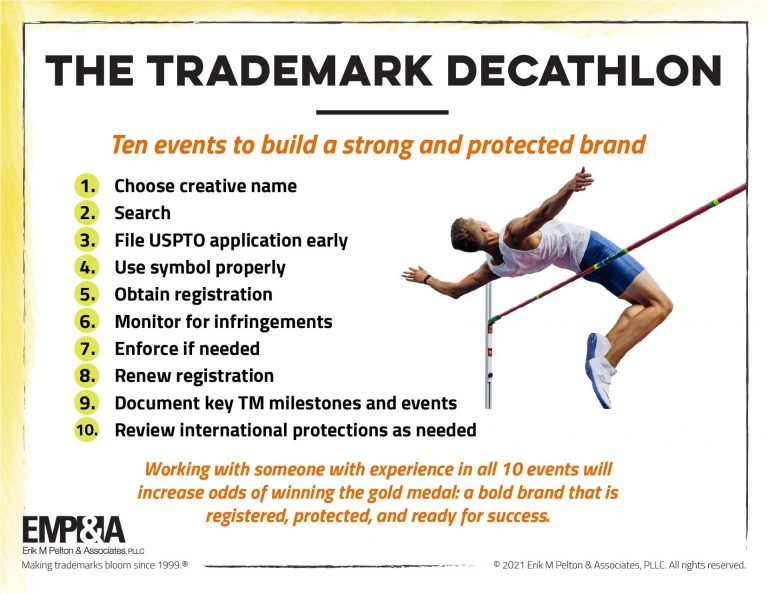The following is an edited transcript of my video, The Trademark Protection Decathlon.
One of the most intriguing events in the Olympics is the decathlon, at least from my perspective. The decathlon was created to try to measure the most well-rounded athletes because it’s not just one event, one competition, it’s a total of 10 events.
In case you’re not that familiar with it, it’s the 100 meters, the long jump, the shot put, the high jump, the 400 meters, the 110 meter hurdles, the 1500 meters (which is about a mile), the pole vault, the javelin and the discus throw. Someone who’s amazing at two or three of these, but really fails at two or three others, doesn’t stand a chance to win the decathlon. You have to be excellent at all of them. And you could win the decathlon without winning any one of the events, so I find it fascinating endeavor.
The Summer Olympics got me thinking about what it would take for a decathlon of trademark protection: to be well-rounded and ensure that a brand, a trademark, has covered all the angles and excels at everything. I’ve come up with the 10 events to solid trademark protection.
1. Choose a creative name. If you start with a boring, or common, or descriptive name, it’s going to be much more challenging.
2. Search before you come into those names. Search and make sure the name is available.
3. File early. Once you’ve chosen a name, searched it, hopefully started working with an attorney—and we’re going to get to that in a second—you want to make sure that you’ve searched it to really make sure that it’s available in your field of goods and services. You want to file early. Now that you’ve committed to the name, you’ve invested in the search, file early with the USPTO. You can even file with intent to use.
4. Use the symbol properly. While it’s pending, use TM or the SM. Once it’s registered, use the R with a circle.
5. Achieve registration. See the application all the way through. Of course, there are a variety of steps and it takes over a year on average these days.
6. Monitor continuously for possible infringements.
7. Enforce your trademark, if necessary, by sending cease and desist letters, or take down notices, or otherwise engaging with infringements.
8. Maintain and renew the registration to make sure it stays valid for as long as possible.
9. Document key trademark milestones and events throughout this process. By keeping records of the search, the filing, the first using commerce, etc., you make it much easier to add value to that trademark portfolio, to deal with problems, to transfer it.
10. Research and review international protections as needed as your brand grows. As you move into other markets or your customers come from other markets, you want to make sure that you’re thinking about international protections for your brand.
I could maybe complete a decathlon, I could maybe jump over a hurdle, probably not jump over the high jump, but most of the other things I could do. But without a coach, without training, I would barely make it to the finish line, and same thing goes for the trademark decathlon. An experienced guide will undoubtedly make the process better, more effective, and more efficient. While it costs some money to have an experienced guide, in the end it’s almost guaranteed to save money by improving the value, improving the protection and lowering the labor and thought that you have to put into it. Working with someone experienced on all 10 of these is going to increase the odds that your brand will win a gold medal — that it will be registered, protected and ready for success.




